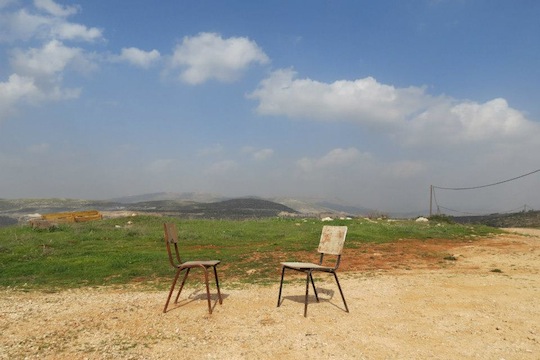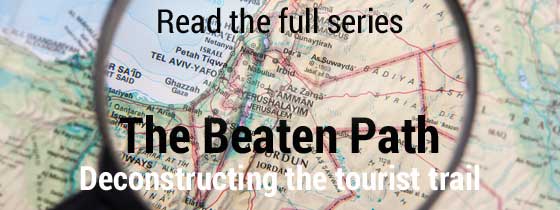Nothing in the Holy Land is very imposing in and of itself. What visitors seek is a connection to holiness, to an ancient story or to one currently unfolding. The deconstructed tourist trail ends with a realization: Everything here is a trace. The final installment in Yuval Ben-Ami’s journey to Israel and Palestine’s most-trodden tourist sites.

On the foothills of the Wasatch Mountains, overlooking the Salt Lake Valley, is a park with a peculiar name. It is called: “This is the Place Heritage Park” and features the imposing “This is the Place Monument.” Ironically, it is not the place, and the bronze figures at the top of the monument are looking away. The place would be the valley below, the one identified by Mormon “Moses” Brigham Young as the promised land. Arriving at this spot following decades of nomadism, Young halted the caravan of the faithful and pointed out the location intended by God for his new chosen people.
The city built in the valley was initially named “Zion.” For someone born in the older Zion, the idea of Utah being “the place” seems far fetched, but is Jerusalem indeed “the place?” Is my Holy Land indeed the same one discussed in the Bible?
A few months ago I visited the mystical city of Urfa, in southeastern Turkey. Traditionally believed to be the birthplace of Abraham, Urfa is situated not far from the Euphrates river, on a major artery of the Silk Road. It is a junction of myths and traditions.
On my return I got back to work and found myself once again in a bus filled with tourists, heading south from Jerusalem to Hebron. I told them that the road we traveled is known by its Biblical name, “The Efrata Road,” and that I had no idea why. In Hebrew, Efrata would mean “to Efrat,” or “to the Efrat.” Today there is a town named Efrat on this road, but it it is a modern Jewish settlements named after the road, not vice versa.
And then it hit me: Efrat. This is how people who live along the Euphrates pronounce the name of their river. Could the original Efrata road been the road to the Efrat, the silk road passing through Urfa, that major artery of ancient civilizations that connected Mesopotamia and the Mediterranean? Could the stories of Isaac, Rebecca, Rachel and Jacob, told in the book of Genesis, have been initially set over there, and then traveled here, to support a political claim over Canaan, one that would turn Canaan into the “land of the Patriarchs?” Could it be that this is not, in fact, the place?
The empty room
Travel in the holy land is a lot about touching. Pilgrims touch the Wailing wall, the Stone of Anointing at the Church of the Holy Sepulchre, and the rugs at Al Aqsa Mosque. Political travelers touch the concrete of the separation barrier or plant trees in memory of the righteous among the nations.
Nearly everything we touch can be questioned. Take the Stone of Anointing. We will never be sure whether the Church of the Holy Sepulchre marks the authentic grave of Jesus and the Calvary. The place was identified by St. Helene in the fourth century, and she was not an archaeologist. She was the mother of an emperor who had just converted his empire, a woman guided by the power of her spirit and by input provided by local Christians.
So the hill may or may not be the right hill — but the stone itself, said to be the one on which Jesus was wrapped in shrouds, is definitely not the right stone. An earlier stone was smashed to bits, when the sixth Fatimid caliph, al-Hakim bi-Amr Allah, demolished the original fourth-century basilica. A new slab of marble was brought here in the 18th century. Pilgrims kneel down to the floor to touch the marble, they pour holy water over it and soak the water into handkerchiefs. They take with them the spirit of Christ preserved in the stone — the wrong stone.
Thing is, the spirit is there. It makes absolutely no difference whether the stone is authentic or not, or whether the church’s location is exact. This church has been Jerusalem for the Christian world for nearly two millennia. It is infused with the energy of countless pilgrims. Those who soak their handkerchiefs in water do come home with something. I am certain.
All those things we touch here are representations, or “traces,” to use the term favored by Jacques Derrida (I promised to refrain, but one cannot use the word “deconstruct” a hundred times in a series and not credit Derrida once). They are not the thing itself. The separation wall is not the occupation, the tree at Yad Vashem is not the virtue of saving a human life.
Tourism in Israel/Palestine is “trace” tourism. When we behold the Eiffel Tower or the lower falls at Yosemite, they are an actual tower and actual waterfalls. It is the sheer size and the great beauty of the two that crate the impact. Here, on this small stretch of turf betwixt the Jordan and sea, nothing is very imposing in itself. What visitors seek is a connection to holiness, to an ancient story or to one that is currently unfolding. Everything we touch is a reference.
Visiting the Holy Land is so much like reading poetry. I donot need to hold the actual heart of Emily Dickinson in my hand in order to commune with it. That would be horrible. What I need instead is to read her words. Coming to this land is akin to reading them for the first time in the original, not in translation. By being here, one meets members of the societies that live here and sees how they really live; one gets stuck on the Sabbath without public transportation; one learns how hot it is, and that Israel is far less rich in bagels than would be expected. An open-eyed tourist notices history that is invisible when observing this place from afar: Canaanite, Byzantine, Mameluke… Chatting with a stranger at a bar or on the train, he or she would encounter new narratives: Mizrahi Jewish, Marxist Palestinian, progressive settler…
Coming to this land has got to be, and inevitably always is, a philosophical experience. Whether or not this is the place matters as much as whether the Dickinson tome is or isn’t first edition. First editions are nice, but that is not the point. What matters most here is that which we cannot touch, the poetry, if you will, and poetry is to be found here, in abundance.


